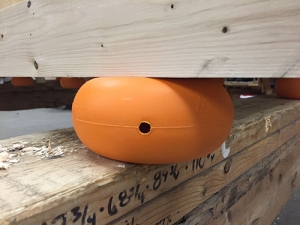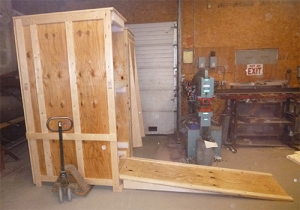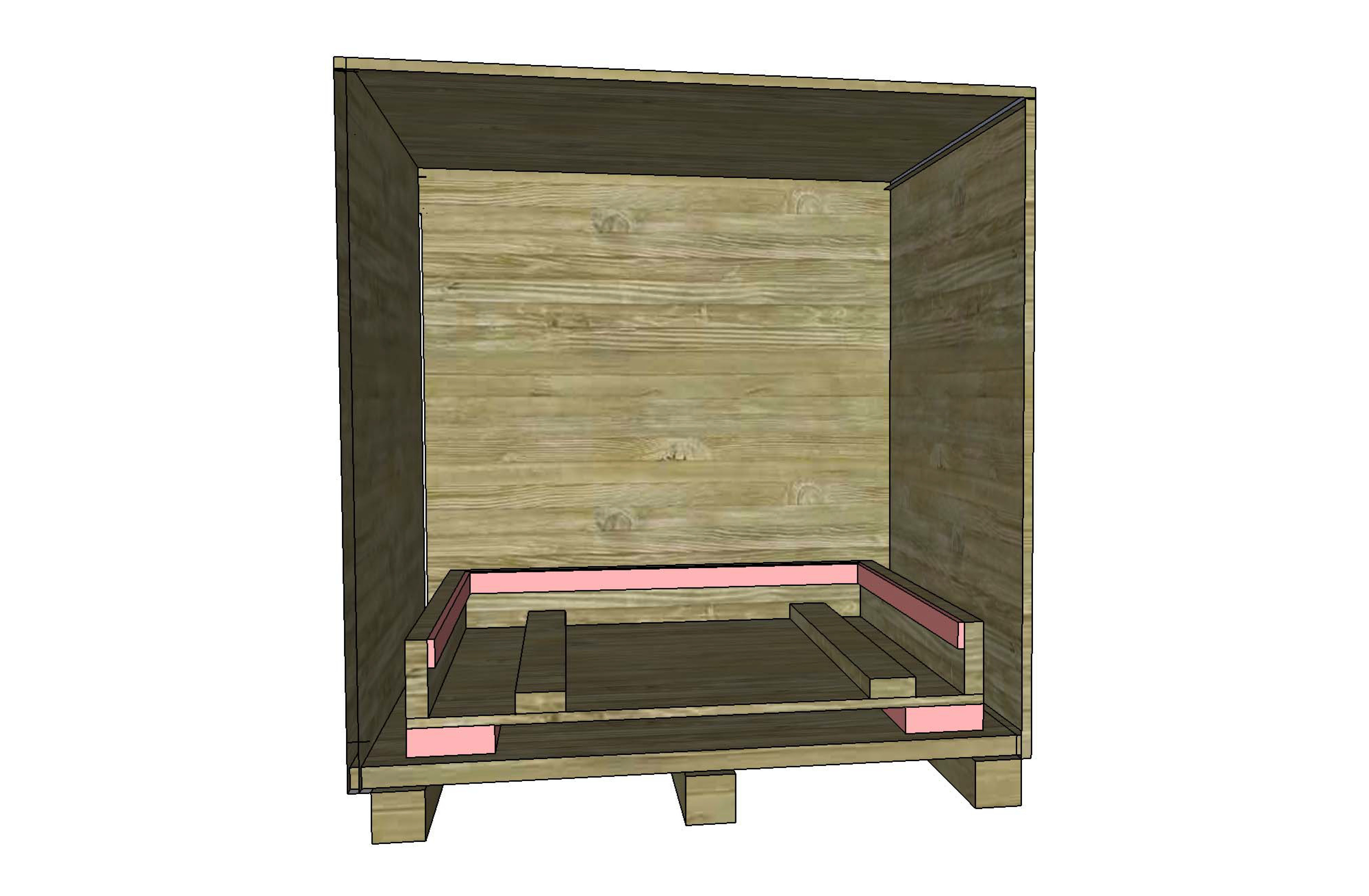You make packaging choices every day. You put last night’s leftovers into Tupperware or Ziploc without a second thought. You probably never falter when asked “Paper or plastic?” at the grocery store checkout. But choosing the right shipping crate can be surprisingly complicated!
Infinite Variety
You might imagine that shipping crates are a one-size-fits-all solution for shipments that are too heavy or large for a cardboard box. But off-the-shelf crates come in a wide range of sizes and strengths. If you choose to have a custom crate built, your options become almost limitless. By definition, a custom crate is the perfect size and strength for your shipment. But did you know that it can also include extra features that help protect your product from moisture, shock, or vibration during transit, make it easier for your customer to unpack your product, and even allow the crate to be re-used?
Finding the Right Balance
Ordering a “Cadillac” of a crate, that includes all the potential upgrades and offers the ultimate level of protection, may not be a sustainable business model. But automatically ordering a “Dodge” crate, with minimal extra protections, might turn out to be more costly in the long run if preventable damages occur.
So how do you choose which packaging options are worth the investment? The trick to choosing the “just right” custom crate is to weigh the risk of damage from moisture, shock, or vibration against the cost of a custom crate with all the bells and whistles.
- The first step is to prioritize which type(s) of damage would be most costly to your shipment. For example, moisture can cause irreparable damage to machines with exposed metal surfaces. So preventing condensation inside the crate will be critical. If you’re shipping equipment that is precisely calibrated, vibration is likely to be at the top of your list of dangers.
- Then, inquire which options and upgrades can best help reduce the chances that your shipment will encounter the risks you’ve identified.
- Request an official price quote that breaks down the cost of the custom crate by feature.
- Finally, compare the cost of each feature to the likely cost of repairing or replacing the equipment if it suffers damage during shipment.
You might be surprised to discover how large an impact a small investment can have on the safe arrival of your shipment. For example, upgrading the base of your crate from a pallet to a skid can offer much greater protection from shock and torque and might represent a difference of only $15-$20.
Optional Improvements
Here are some upgrades you may want to consider when ordering your custom crate:
Lumber Grade
The quality of the raw materials make a huge difference in the quality of the finished crate. The lower the number, the better the wood. Moving from #3 to #2 or even #1 lumber will result in a sturdier, better-looking crate.
Bottom Layer
Even if your product is lightweight enough to be transported on a pallet, it’s worth considering upgrading to a skid. (A skid is essentially a pallet with a solid deck onto which equipment and packaging materials can be secured.) Skids provide a much sturdier foundation for the entire crate structure.
Cushioning
Foam cushioning is the best option for preventing damage from bumps, bangs, and drops. Available in a variety of types and densities, it can be custom-cut to fit your equipment like a glove. Upgrading to a more expensive foam can help mitigate vibration, in addition to the standard shock protection.
Skid Mates
These round plastic donuts don’t look like heroes. But adding skid mates to the underside of the skid will drastically reduce vibration during shipment.

Multi-Directional Pad
For particularly heavy or delicate equipment, consider upgrading to a multi-directional pad, which is constructed from two pieces of plywood with a specialized foam and tube layer in between. The pad will lie beneath the equipment to absorb vibration from several directions simultaneously.
Anchoring
It’s important that your product be secured to the skid so that it will not shift or tip within the crate during transit. Lag bolts perform admirably, but upgrading to through bolts may allow for the crate to be re-used. For shipments to trade shows, ratchet strapping is preferable to any kind of bolting because it can be undone quickly and easily without any special tools.
Foam Cap
The best cushioning protects your equipment from head to toe. Wooden blocking attached to the inside of the lid of the crate will help ensure that your equipment stays locked in place within the crate. Adding a “cap” of foam cushioning further protects vulnerable pieces on the upper half of your equipment, especially if other crates are stacked on top of yours.
Fasteners
Crates constructed using nails may be fine for single-time use. But if your customer plans to re-use the crate, or the equipment inside is delicate, it’s worth upgrading to screws. That way, nobody will have to use a crow bar or claw hammer to dismantle the crate while it still holds sensitive equipment. For shipments to trade shows or crates that contain samples that will travel from customer to customer, consider upgrading to link locks. These twisting latches can be opened and closed quickly without special tools, making them ideal for the trade show floor or other multiple-use scenarios.

Strapping
Wrapping the fully assembled and packed crate with strapping is not strictly necessary, but it does help maintain the integrity of the crate. Plus, the TSA requires all crates that will be transported via plane to be strapped. Most metal and plastic strapping is designed to be used only once and snipped off the crate upon arrival. Straps with clips are available for crates that will be unpacked and re-packed multiple times.
Aesthetics
The shipping crate will actually be your customer’s first impression of your delivered product, so pay attention to the “look-and-feel” of your packaging. Consider upgrading to plywood that will present a finely sanded side, free from splinters. Painting the crate or adding a screen print or stencil of your company logo can further amplify your first impression.
Integrated Ramp
Consider how the crate will be unpacked once it arrives at your customer’s site. Will they need to rent a fork truck or crane to lift the equipment out of the crate? If your product has wheels, you could add an integrated ramp to one side of the crate and save your customer serious time, expense, and headache.

Indicators
Some customers will appreciate an extra level of detail about the challenges their shipment encountered during transit. Adding a shock or tilt indicator to the outside of the crate will inform the customer whether the crate was dropped further than or tipped past appropriate parameters. Installing a moisture sensor inside the crate (that will remain visible from outside the crate) can be very helpful to customers who plan to store their equipment for any length of time after the delivery arrives.
Security
If security is a concern for your customer, tamper-evident tape applied to the edges of the crate will indicate if anybody has accessed the crate en route. It can act as a deterrent, but it won’t actually prevent tampering. Upgrading to screws with tamper-resistant heads provides a second layer of protection because would-be tamperers would need to have a screwdriver with a specialized head in order to undo the fasteners.
“Just Right” Crates from CDC Packaging
It can be a challenge to choose a custom packaging solution that provides the protection your shipment deserves without breaking the bank. CDC Packaging offers the full range of custom crates, from “Cadillac” to “Dodge” and everything in between. Contact us today so we can help you achieve the best protection for the smallest investment.

